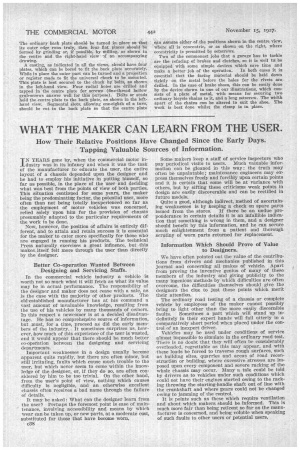WHAT THE MAKER CAN LEARN FROM THE USER.
Page 176

If you've noticed an error in this article please click here to report it so we can fix it.
How Their Relative Positions Have Changed Since the Early Days. ' Tapping Valuable Sources of Information.
IN YEARS gone by, when the commercial motor industry was in its infancy and when it was the task a the manufacturer to educate the user, the entire layout of a chassis depended upon the designer and he had to employ his initiative in putting himself, so far as possible, in the place of the user and deciding what was best from the points of view of both parties. This situation continued for some years, the maker being the predominating factor, the potential user, more often than not being totally inexperienced so far as the employment of motor vehicles was concerned, relied solely upon him for the provision of chassis presumably adapted to the particular requirements of the work to be done.
Now, however, the position of affairs is entirely different, and to attain and retain success it is essential for the maker to cater more specifically for those who are engaged in running his products. The technical Press naturally exercises a great influence, but this makes_ itself felt more through the user than directly by the designer.
Better Co-operation Wanted Between Designing and Servicing Staffs.
In the commercial vehicle industry a vehicle is worth not so much what it will fetch as what its value may be in actual performance. The responsibility of the designer and maker does not cease with a sale, as is the case with the majority of other products. The old-established manufacturer has at his command a vast amount of invaluable knowledge, resulting from the use of his vehicles by many thousands of owners. In this respect a newcomer is at a decided disadvantage. He has no comprehensive source of information, but must, for a time, proceed as did the early members of the industry. It sometimes surprises us, however, thow much of this experience of the user is wasted, and it would appear that there should be much better co-operation between the designing and servicing departments.
Important weaknesses in a design usually become apparent quite rapidly, but there are often minor, but still irritating, faults which cause much trouble to the user, but which never seem to come within the knowledge of the designer, or, if they do so, are often considered by him to be too trivial. On the other hand, from the user's point a view, nothing which causes difficulty is negligible, and an otherwise excellent chassis often receives a bad name through the failure of details.
It may be asked : What can the designer learn from the user? Perhaps the foremost point is ease of maintenance, involving accessibility and means by which wear can be taken up, or new parts, at a moderate cost, substituted for those that have become wOrn. Some makers keep a staff of service inspectors who pay periodical visits to users. Much valuable information can be gleaned in this way; the truth may often be unpalatable; maintenance engineers may orpress themselves freely and forcibly upon certain points and it is certain that some will be at variance with others, but by sifting these criticisms weak points in design are easily discoverable and can be rectified in future models.
Quite a good, although indirect, method of ascertaining weaknesses is by keeping a check on spare parts Issued from the stores. If there be an undue preponderance in certain details it is an infallible indication that something is wrong in them, and a designer should benefit by this information, and he can secure much enlightenment from a patient and thorough scrutiny of worn parts returned for replacement.
Information Which Should Prove of Value to Designers.
We have often pointed out the value of the contributions from drivers and mechanics published in this Journal and concerning all makes of vehicle. Apart from proving the inventive genius of many of these members of the industry and giving publicity to the many ingenious methods by which difficulties are often overcome, the difficulties themselves should give the designers the clue to just those points which merit their attention.
The ordinary road testing of a chassis or complete vehicle by employees of the maker cannot possibly bring to light other than the more easily discernible faults. Sometimes a part which will stand up indefinitely in their expert hands will fail utterly in a comparatively short period when placed under the control-of an inexpert driver.
Vehicles may be used under conditions of service almost impossible to simulate in the ordinary road test. There is no doubt that they will often be considerably overloaded, regrettable as this may appear, and with these loads be forced to traverse rough surfaces, such as building sites, quarries and areas of road reconstruction or building, where excessive stresses are imposed upon every component and severe racking of the whole chassis may occur. Many a tale could be told by drivers as to vehicles under such conditions which could not have their engines started owing to the racking throwing the starting-handle shaft out of line with the crankshaft and where gears could not be changed owing to jamming of 'the control.
It is points such as these which require ventilation and about which makers should be informed. This is ninth more fair than being reticent so far as the manufacturer is concerned, and being voluble when speaking of such faults to other users or potential users.












































































































































































































































































